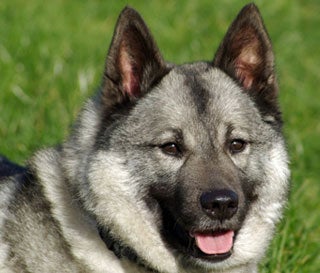Learn about dog breeds
Detailed information & photos on over 190 different breeds
Description
The Norwegian Elkhound is a medium sized dog similar to the Spitz in that it is muscular and compact; his temperament is closer to a hound, as is his ability as a hunting dog. He has straight legs, a deep chest, a long rib cage and looks heavier in the front because of his chest and ribs. He holds his head high on his solid neck and has triangular pricked up ears on his wedge shaped head. His mouth and nose taper and he has strong jaws. His tail is curved and has a fullness to it that makes it look plumed. Interestingly, Norwegian Elkhound puppies are all black at birth and they lighten as they age.
Coat Description
The Norwegian Elkhound has a dense coat that is darker on the upper body. The coat is shorter at the dog's face and he often has dark markings. Undercoat and underside of the dog's body will often be lighter in color than his back. The coat is water and dirt resistant because of oils in his skin and fur.
The under coat is light, either gray or silver in color. There are black markings on the dog's muzzle, tail, and ears.
History
Originally a Viking dog, the Norwegian Elkhound has been used for thousands of years as a hunting dog, a herding dog, and a guard dog. He is thought to be one of the oldest domesticated dog breeds still in existence today. As a hunter, the Norwegian Elkhound is quite successful. His nose is very powerful and he can track game well. The breed would hunt in packs, surround the game, and bark to alert the hunters where they were and that they had cornered the game. Some of the game the breed was used to hunt were moose, badger, caribou, rabbits, reindeer, and even bear, but never elk. More recently, the breed was commonly used as watch dogs and guard dogs.
Temperament
While the Norwegian Elkhound is a good family pet, he has a very prominent independent streak; he will often be stubborn to obey commands. He is good with families with children, and is a very natural guard dog and watchdog. The Norwegian Elkhound is loving towards his family, but does not trust strangers and will bark extensively when he feels the family could be in danger. They should be included in family activities and even though they are independent, they prefer to be with their families.
The Norwegian Elkhound can be aggressive towards other dogs, so he needs a lot of socialization training when he is young to keep him from fighting with other dogs. Males should be neutered to prevent same sex dog aggression. Unless the Norwegian Elkhound is raised from a young age with cats or any other pets, he will not adjust well to them. The dog should always be supervised with smaller animals like cats, as they are natural hunters and could easily hurt or even kill a cat.
Health Problems
Even though he is a medium sized dog, the Norwegian Elkhound has a lot of the same health problems that large breed dogs have. He is prone to hip dysplasia, progressive retinal atrophy, and pyotraumatic dermatitis (also called "hot spots", they are lesions that are often itchy and uncomfortable). Some Norwegian Elkhounds also get Faconi Syndrome, a kidney problem.
Grooming
Like other breeds from Northern countries, the Norwegian Elkhound has a double coat with a stiff outer coat and a wooly, soft inner coat. While the outer coat doesn’t usually mat or tangle, the inner coat does. Therefore the dog needs to be brushed a few times a week with a stiff bristled brush or pin brush. The breed is an average shedder with heavy seasonal sheds in the spring and fall. Regular grooming will also help the owner keep an eye out for hot spots on the dog's skin. Bathing is only needed infrequently, and specially formulated dog shampoos should be used.
Exercise
The Norwegian Elkhound needs no less than one hour of physical exercise very day. More is much better as the dog loves to be outside and play with the family members. He will run around the yard with children, or will enjoy long walks or even jogging with his master. The breed needs to be on leash when he is out of his yard because he is instinctually a hunter and will chase smaller animals. They do well in a dog park when they have been socialized from birth and are neutered or spayed.
Training
Because of the breed's streak of independence, they need to be socialized and trained from an early age. This will prevent any problems with dog aggression or stranger distrust. The dogs will learn to trust and obey their masters provided that they are taught to have manners and are trained with positive training methods and not negative ones.
The dog will actually consider a command from his owner before he does the commanded action. They were also bred to be watchdogs, so the breed will bark at strangers and potential threats unless trained not to do so.
Training sessions should begin with exercise so the dog can use up some of his energy and be calm enough to focus on the training. Obedience training with positive reinforcement methods is ideal for the breed, as is socialization training. Training should be repetitive and it should be noted that the breed gets bored quickly.
Advertise | Privacy Policy | Terms of Use | Contact Us © Copyright 2004-2024 PupCity.com. All rights reserved.
